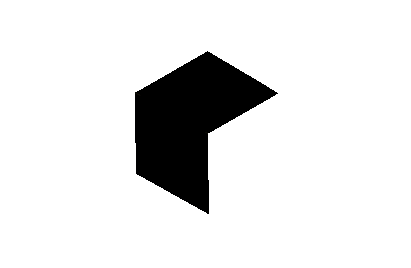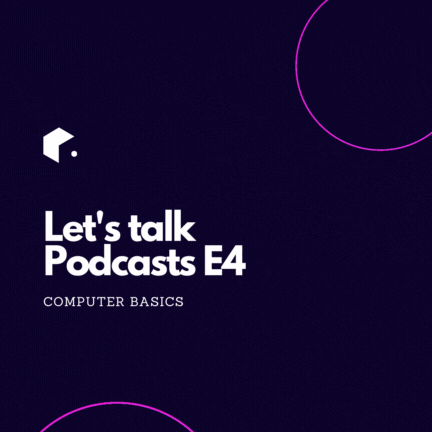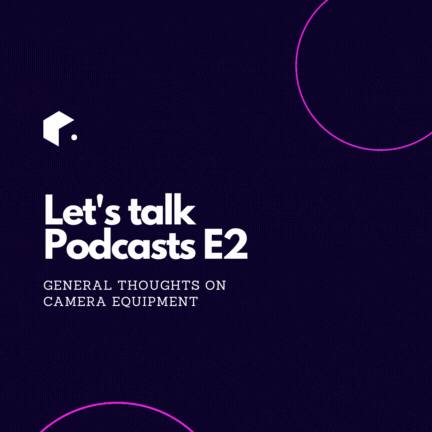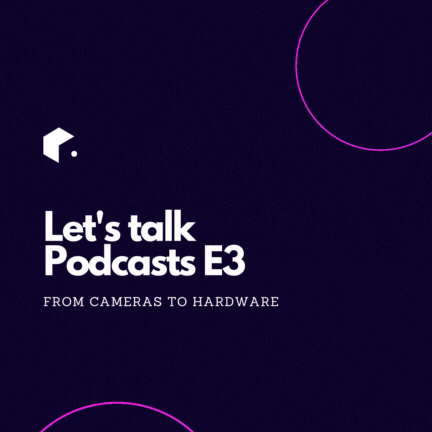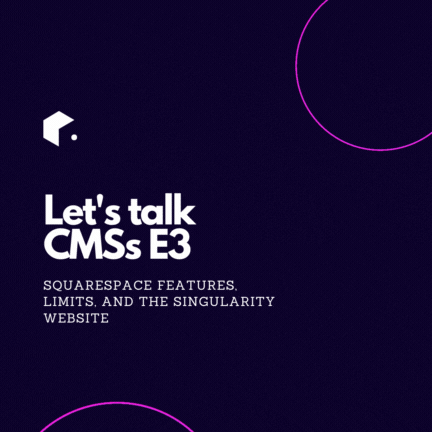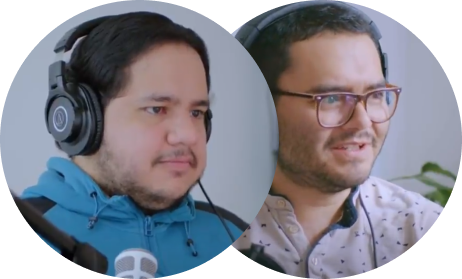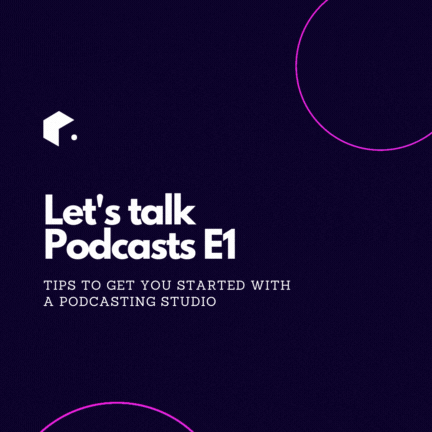
Let's talk Podcasts E1: tips to get you started with a podcasting studio
In this podcast episode, our hosts, Diana and Diego, discuss the basic steps and key considerations for setting up a home or office video studio. The conversation heavily focuses on the importance of investing in good lighting and sound, providing specific equipment recommendations and advice on how to best use them, including USB and Lavalier microphones. Diego also shares helpful tips on how to combat environmental noise and improve video production quality. They'll be continuing this conversation in future videos, talking about cameras, composition, and more elements crucial to creating high-quality video content.
Episode transcription
[00:00:00] Diana:
Introduction and Welcome
[00:00:01] Diana: Well. Hello everyone, welcome back again to another podcast episode. Diego is joining me today. Hi, Diego. How are you today?
[00:00:12] Diego: Dear Diana. Thank you for the invite. How are you?
[00:00:16] Diana: Cool! You're welcome.
Recap of Previous Episode: Video Editing Apps
[00:00:19] Diana: Last week we had a conversation about how to work with two video editing apps, applications called Riverside and Descript. So, we talked a little bit about the advantages of both apps and my experience working with both apps, and why choosing one over the other. That was a very interesting conversation.
The Importance of Pre-Production in Video Making
[00:00:54] Diana: So, I would like to expand a little bit more, but this time, I want to focus on the process of making a video, especially the first steps when you are... when you want to produce videos by yourself. I want to talk today about how to set up your, it could be either, your home studio or your office studio.
So, today we're going to talk about the previous, the behind-the-scenes, the BTS of making videos. What you see, for example, when you're watching a YouTube video, a five-minute YouTube video, or an hour YouTube video it's one thing, but everything that is behind that video: the production, the planning, all of that also requires lots of energy, lots of time, and lots of logistics, in my opinion. So, let's begin from, I'm sorry if I'm being redundant, but let's begin from the start, from the beginning.
Setting Up Your Home or Office Studio
[00:02:10] Diana: So, Diego, if a person is thinking about or, yeah, is considering producing videos on their own, what should be the first step to take?
[00:02:26] Diego: Okay. Thank you Diana. And, yeah, it's a topic. It's a huge topic. So...
[00:02:33] Diana: It is.
[00:02:33] Diego: Answering your question, I'm going to try to limit this to this kind of setup we are working with right now because there are many types of video productions. So...
[00:02:45] Diana: Abolutly.
[00:02:45] Diego: We might be talking about something like holding your phone and recording yourself for something... it doesn't have to be TikTok, any kind of video format can go to any platform, but what I meant is it can be something on which the workflow will be on the move. Okay, or it could be something for advertising on which you have a setup that can't be a one like this, over here this is like more of a podcast or video called, or webinar or overall hap talk as well a kind of work or office workstation setup. So, there are many setups. So, I'm going to limit my answer to this specific kind of setup. We can possibly talk about other kinds of productions later on. So, for this one... who... there are different things to consider.
Importance of Lighting in Video Production
[00:03:55] Diego: My favorite one is always lighting because I am the person who thinks that artists shape colors to do a painting, and we're musicians shape notes to shape a song. I believe that video producers, whether it is the director of Oppenheimer, or a YouTuber, they shape light in order to create videos. So, I like to start with light because I believe that's one of the most important factors and also one of the most forgotten ones.
So, lighting. Let's serve with that one. Lighting is extraordinarily important. The quality of it and how you use it is pretty much everything. So, one of the first things that I will tell someone to consider when producing something is to consider the lighting. Now, it doesn't, it is not... this is not equal to ꟷHey, you have to purchase lighting equipmentꟷ. It's totally possible to produce without purchasing lights, but even so, you have to consider lights.
Understanding Natural and Artificial Lighting
[00:05:17] Diego: For instance, my current setup is having a window right over there, and we are recording at something like 3:00 PM over here. So, that is my main lighting source right now. And if I... I have another like that one, is an artificial one that I purchased, that is over there. And even if I turn that off, like this, reality is that I'm still having light, and I can still totally do a production under this environment with a natural light. But hence, I consider that when setting up my station. I turn that on again. Now, the reason why we will need an artificial light will be something like we might want to control the light to make it stable because the sun, I have no control over it, so, if clothes are passing through as I'm recording a one hour video, a podcast or something like that, chances are that camera gets very hard variations on the scene, so, it might get a lot darker or a lot brighter. So, having artificial lights can allow you to mitigate that potential problem, but...
[00:06:53] Diana: So, you will say that one of the, considering lighting, one of the first things to acknowledge is your space and whether your space provides natural lighting or... what type of natural lighting your space will provide and how artificial lighting can make it even better, especially because natural lighting is changing all the time.
[00:07:24] Diego: Absolutely. So, there are many things to consider here. I believe that working or providing advice for lighting will be worthy of the very least two episodes on itself 'because there are many things to consider depending on how you want to set up your station. But, as a summary, which is what I want to give on this answer, lighting: considering it, not necessarily purchasing it, but considering it is absolutely important for your recording. So, that is the point on which I will definitely advise someone to get started. For instance, like... a very... just as quick mentions, if you have a window and you want to record, you don't want to hit record, or place your recording that's... like... again, we're assuming that you're a person who wanted to have the computer desktop in your home office studio, and you want to place everything in there so that you can just sit there record as you are working. So you don't want to place that here if you have a window over there on your back. 'cause If you do that, you will be underexposed...
[00:08:49] Diana: Counter, counter, exactly.
[00:08:51] Diego: ...very bright. Exactly.
Tips for Effective Lighting
[00:08:52] Diego: So, that is just an example on the fact that you have to consider it. Even if you do not purchase lights, you have to totally consider how your natural lighting is working on the environment that you're going to be setting your home station on. And if you purchase that, then, as a bite of information because, again, there's a ton of materials that we can't cut here on other podcasts focusing only on this, if you purchase lights, I will advise you to purchase or to create on your home office something that can... I don't know if that word exist: difuminate or, how may I say that?
[00:09:47] Diana: Mhm, yeah. Absolutely.
[00:09:49] Diego: Okay. Yeah. Like you don't want a laser focused like punching you right in your face. What you want is a light that can be spread out all very softly. So, that is why many lights are having like a... I don't know how to say this, a plastic white... cover between the lead and yourself because the more the lights are soften it the better it looks like, that is why in cinema setups...
[00:10:33] Diana: Yeah.
[00:10:33] Diego: ...they have like those...
[00:10:34] Diana: Yeah,
[00:10:34] Diego: ...very big wide things of clothing that are in between the light and the talent because you have to difuminate the light. So...
[00:10:46] Diana: Yeah. You have to make a dim, like a dim light. Yeah.
[00:10:51] Diego: Like spread that out, you don't want to have a light just... a flashlight just... punching you into your face. So, the more spread it out, it will be better. And that is why the...
[00:11:11] Diana: You will say like evenly distributed along the space, is what you are...
[00:11:16] Diego: Not exactly...
[00:11:16] Diana: ...you are meaning to say?
[00:11:17] Diego: The light can definitely be pointing at you. I would love to have some sort of sample over here. Okay. Let me show you something.This is a lamp, inside this lamp, which is sort of a wide material, cloth material. Inside of this, there is a light bulb. It won't be the same if I had this lamp over here only, I mean, without this material that is kind of softening the light a little bit. That having just a bulb punching me into my eyes. If you see that bulb with your eyes directly, you'll be kind of... it is hard, all we want is contrary to that hardness feeling with your eyes. We want to be soft, and for the camera, you have to do that the very same treatment. You don't want to be hard with the light to the camera. You want to be soft. So, the principle is the same, like the lights that you will purchase will have something of material that will be making it more soft, or you...
[00:12:29] Diana: Yeah. You don't want to look like a deer in front of a headlight. I understand what you mean.
[00:12:35] Diego: For example. I don't want to point this into my face. I don't want to have something like this on my desk because this is going to kill the shot. It's too hard because...
[00:12:47] Diana: And it's going to be as well, way too uncomfortable.
[00:12:49] Diego: Aside from being very uncomfortable, it is going to be uncomfortable for the camera as well. Yes, better cameras can definitely handle this better. But the idea is let's back to the beginning. It is all about painting with light. So, instead of this punching you into the face on your desktop, sitting there in your desktop like this, what you want is to have something like this. Which is not going to punch you and the more soft or softer, the better. So, that is a very quick summary on lighting. But, yes, the very one thing that I will tell anyone to focus on will be lighting, definitely.
Choosing the Right Lighting Equipment
[00:13:33] Diana: So, as a very quick question, because I know that we're going to continue this conversation later on in future podcasts. If you had to recommend me or anybody a type of lamp, or a brand of lamp or lighting, that you can begin with, okay? This will be a perfect type of lamp or a perfect type of brand for a person who's beginning setting up their own studio. What would that be?.
[00:14:09] Diego: Ooh Ooh Tough question because I'm not a guy who likes to marry with brands. Aside from that, I'm a YouTube reviewer, so it is not like I have had hundreds of lamps...
[00:14:20] Diana: Or what should be the characteristics? What should be like the optimal characteristics of these lamps in order to work?
[00:14:29] Diego: Exactly, like this one I'm having over here is Godox And it work...
[00:14:34] Diana: Which is the same one...
[00:14:35] Diego: Exactly...
[00:14:36] Diana: It is the same one that I'm using?
[00:14:38] Diego: I like it, I will recommend that, but it isn´t like I will recommend that because I have explored 100 of those types of lamps 100 brands and this is the better It´s just, I had a good experience with that one. I have... weh ave other brands and types of lights at the office. So, let me re-elaborate my answer. I would rather start with what you require. For example, there... let's talk about one type of possibility. There are those big, huge, soft boxes... I'm sorry, (sneeze) my apologies. There are those huge boxes for lights that are very often used on interviews and other kind of situations. Many YouTubers have those, of course, professionals on documentaries, interviews, and cinema use that those as well. So there are those that, you can purchase and set up into your office, but then you will have a very cumbersome C Stand, which is a device which you can literally hang the lamp on, and then you will have a very huge thing in middle of your home office. So, depending on whether you like that and that is convenient for you in your home office and your environment, in your home, or even in your office, it might be like very cumbersome, depending on how you see that for this situation and a specific time that might be a good or a bad solution for you. So that there, if that is not for you, then I will be forgetting about that and I will be going for something simpler. Simpler might mean... might it be something like that one that you're using that is a Godox lamp that is surface squarish rack of flats of leds.
[00:16:42] Diana: It is.
[00:16:42] Diego: Led Lights.
[00:16:43] Diana: I have it over there. Exactly.
[00:16:44] Diego: Exactly. And the lamp comes with a tube that you can put in your table and you can adjust that lamp to your desk table to point at you. That will be an interesting solution, that I like that kind of lights. Godox is just a brand, is one I would recommend it, but there are many brands that can have those types of lamps. I believe that one is very easy to set up, that it is high quality, but It's not the only alternative. There are many others, and one that I love is easy to conceive within your environment. It's just a lamp like this one over here. Inside of this, there's just a standard LED bulb. Just try to purchase something that is high quality; it does not have to be something special for cinema; we aren't producing cinema; this is for podcasts, for that kind of things. But I would purchase a light bulb that will be high quality and have a lamp right over there, and that's it. It will be a lamp that can fit within your home, when you are seeing it as a home; that can fit within your office, when it is your office, and it can serve the purpose of providing you light to your shot when it is a podcast or a webinar, whatever.
So, that is... I believe after having told you about those three kinds of solutions: like the big, huge, soft box, with a system second, the more easy to swallow solution, like this one that we're using from Godox, and the standard lamp that you'll have in your office. I believe that I would recommend something who is getting started, especially if that person is not like ⸺I'm going to be a professional YouTuber something, I'm just having my business and I'm producing content for it⸺. I would recommend that person get started with this kind of lamp because it fits very well in your office. Yes, please go ahead.
[00:18:54] Diana: Great. May I add something more to what you said? I'm talking about from my own experience, but talking about people who would like to begin producing videos, business owners, etc. If they have the chance to buy a lamp with control remote, go for it, because this facilitates the process of setting up your studio because you wouldn't have to be standing up and sitting down constantly in order to calibrate, in order to position the lighting in the place that you would like the lighting to be, or even changing the temperature, I'm sorry, changing the temperature of the lighting is something that you will need to do by looking at yourself in the camera viewfinder and see which lighting works best for you. So, if you have the chance to buy a lamp or a lighting equipment with control remotes that you can work on from your seating area, it will facilitate the process so much.
I'm not saying that this should be a must. I'm just saying that it makes your life easier, however, the types of lamps that you recommended before, like to begin with are also a good idea, especially the one that you mentioned. Exactly. So that I like it a lot because I'm able to adjust the lighting of my studio without having to sit down and sitting down and standing up all the time.
[00:20:32] Diego: I totally agree with that. Yes, absolutely. By the way, one of the reasons why I started with the light as well is because you can't have it, maybe you have already something this, so it will be free, or maybe you want to purchase something like that. So, it'll be like, I don't know, $90? And And this is a good brand, like they're cheaper. I will go only go for cheaper, though; I will leave that 90. What I mean is many people start building a budget with the camera, and are thinking about. Okay, the camera that. The camera, they're $2,000 for a camera. But, hey, you can invest just $100 in something like that and have good lighting no matter what camera. That camera will require you to have good lighting or you can just go free with a land that you might already have somewhere in your house or in your office. And yeah, that's a huge investment. Even if you don't spend money your time into this is definitely first thing that I will do. Okay.
[00:21:42] Diana: And it's a difference between a video that looks or doesn't look professional and that's what you want to convey with your videos. You want your videos to look as professional as possible because that's part of your brand, if you're a business owner, for example . Great, so, lighting would be a great way to start, although we're going to expand on the subject of lighting later on in future podcasts. What do you think should be the second thing to consider when setting up your home, office or your studio office?
The Role of Audio in Video Production
[00:22:19] Diego: Yeah. Ah, I am, I'm thinking about, maybe the second one will be either composition or audio.
[00:22:27] Diana: Okay.
[00:22:27] Diego: Let me think about it.
[00:22:28] Diana: Alright.
[00:22:29] Diego: Composition. I'm saying composition is basically what's the scenario which you're going to be appearing on your video, but I don't whether this as important. The better your scenario, the better it going to be looking in your video, and again, your camera is not going to do magic. If your scenario is not good looking, it won't work. However, sometimes our scenario is a white wall. It's uncomplicated. So, maybe the audio is going to be a better one to focus on next. And I believe it's good one because, just as what a light, people forget about it. You can... if you go to the cinema, if you go to the theater, I'm sorry, to see, to watch a movie, you might be able to support that the movie is out of focus, it's slightly out focus, or have some sort of pinkish, I don't know, tone to it or maybe there's one part of the projection that is having a black space or something like that. And okay, you might forget about it after five minutes on being immersed on the movie, but if you happened to have distorted audio or bad audio of any manner on that movie, you won't stand, you won't support it for more than 30 seconds probably. And it's the same with any other kind of video productions. So, people very often forget a lot about audio, and audio is extraordinarily important. So, the second thing I will focus on will be audio. Now, withing an audio, we have many things. There's of course the quality of the microphone. That's something I will invest; I will absolutely invest in that, no matter what, especially because it is a cheap investment, compared to the camera investment, which many people focus on at the beginning. So, I will focus a lot on audio in terms quality. There are also two other factors that I will consider that, in my opinion, are very important. So, one of those is the environmental noise because many of us, I believe all of us, to be honest, maybe we have a construction next side, or maybe there are dogs on the other side or maybe... Whatever. I mean it's very likely that there environment noises that can affect our production. So, that will be the first one, I will focus on. Assuming that this is a home office, that this is not a closed environment, that is prepared, it's so prepared, and all of that by some engineers to stand out or to be isolated from the rest of the world; assuming that, yes, focusing on... try and find a sound solution that can pick only your voice and very little about what's happening around that will be very important. And the third factor that I will consider with audio will be easinnes of use, and that is very important because audio can be very complex. I'll talk a little bit about your experience with audio in regard to this. You are using a... it's the same mic that I'm using, this is a Rode podcaster microphone, which is USB that there, because there are two versions or two types of Rode podcaster is microphone. And so this one is USB and what that means is that this one is easy to use. It is just plug-and-play. Let me tell you a little bit...
[00:26:14] Diana: Is very easy to use.
[00:26:15] Diego: ...about the other type of solution for you to have an idea on what will happen if we had the other type of Rode podcaster microphone. The other one will be requiring you to plug a cable from the microphone to an interface, depending on the brand this interface might vary a little bit in shape. Let's say that your is a focused right interface. So, you will plug that into that interface. That interface will be plugged into your computer or into anything that will power it up. Then, from that interface, you will be extending a cable either to the camera or if you're using your computer to record. Then, the USB-C charging the interface will do. Then, you'll have to plug a headphone, like this one over here; any headphones can do it, doesn't have to be this one. You will have to plug a cable to the interface and to have someone speak to the microphone as you listen at that, and you move the little knock in the interface to control, to adjust the gain on the volume. So, to as to make sure that the voice is not too loud or too thin and you will have to ask that person that will help you because it is almost impossible to monitor yourself like you're speaking, you're hearing at the same time, that's not really work. So, you will ask that person to say something very loud so as to kind of count for the max volume that person might be speaking on that microphone at certain distance to the microphone.
Understanding Microphone Usage
[00:27:53] Diego: And then you will adjust the interface gain accordingly. So, that is a lot of stuff, and that is why one factor that I will consider will be ease of use, a microphone like this one. It doesn't have to be this brand. It doesn't have to be this specific model. What I mean is a microphone that is created to just be plug-and-play.
Dealing with Environmental Noises
So, that is one factor.
Dealing with Environmental Noises
[00:28:18] Diego: Now, about the other factor that I mentioned before, that is relating the noises, you had that experience with ducks, didn't you?
[00:28:29] Diana: Yes. I believe that with the rise of social media more and more people are making videos in environments that are not suitable. For making videos many years ago, before this whole social media craze, there were professional recording studios, and professional recording studio are always under control and that doesn't happen necessarily when you are setting up your home studio or your office studio. So, in my particular case, like mind you, Diego and I, we are working in different parts of the world. So, even trying to produce these types of videos, it takes a lot of work before even recording and we have to consider, again, noise because the noises that I have in my home studio are different from the noises that Diego has in his office studio. Diego, I believe has to deal with, for example, construction work noise, sometimes, I believe? I believe that your office is in a building, right? You have to deal with all the noises...
[00:29:49] Diego: Yeah, exactly. I'm recording right now on my home office studio. But. yes, what you're mention...
[00:29:54] Diana: Yeah. Which is also in a building, right?
[00:29:57] Diego: Which is also in the building, but...
[00:29:59] Diana: Okay.
[00:29:59] Diego: ...yeah, like... I'm dealing more with noises from the street and also...
[00:30:05] Diana: Exactly. So, your noises are... Exactly. So, your noises are more associated with building life or building environments. In my case it's a little bit different since I don't live in a building; I live in a house, I live in a neighborhood, I don't live downtown. That implies that the noises that I'm going to deal with while recording are a little bit different. So, for example, dogs. I have neighbors with very noisy dogs. So, I always have to consider the time of the day where I can record or like the most optimal time of the day where I can record.
Importance of Noiseless Recording Environment
[00:30:50] Diana: And also I have to consider how I should protect my studio. I should protect, for example, my windows. I have to make sure that my windows are closed. I have to make sure that the doorway is closed. I have to make sure that the bedroom door is closed as well. So, I have to work on making my space as noiseless as possible because, even though, with a good microphone you can mitigate the noise still is a potential threat when you are recording. And, of course, these are things that we can fix in the post-production phase of the video-making process. However, the less noise you have the better because you wouldn't have to worry about that in post-production. So, yes, considering a good microphone, regardless of the brand and considering the noises around your studio are critical in order to make good videos.
Post-Production and Quality of Recording
[00:32:00] Diego: Absolutely. I like that approach or that focus on getting things right while recording, instead of pretending everything to be fixed on post because that makes things so much more efficient and also sometimes, It is not possible to get to the quality level you want on post if what you recorded is just bad. For instance, we're talking about noises here, but bad audio, you can't fix that. So, yeah, it's audio is definitely important here. Absolutely. Yes. Anyways. Show...
[00:32:43] Diana: And hopefully, with... yeah, hopefully with the advances of integrating artificial intelligence in different types of software and apps, I think it's going to become less difficult to fix bad audio, but still, right now, it's important to have the best quality possible when you're making your videos. Yeah. Yeah.
[00:33:08] Diego: Yes, absolutely. Even... if you depend on the post-production process to fix audio the better the quality that your software receives than the better the results. So, if you provide your software with a recording, that is just extraordinarily, and there's certain noises out there in the background, however, those are tiny compared to your voice in the recording. Then software is going to have a very easy challenge when it comes to isolating your voice. So, the better you record it, the better it will go at the end. It's always like that. So, yes, about sound, three factors to think about: the easiness of use, the isolation of your voice with respect of the other noises in the environment, and the quality, of course, like how good it sounds to your voice on a microphone. Now, just give you a reference, you might be thinking about 150 to $400 USD on mic equipment. Like 400 is like if you want the best of the best that you can have for these kinds of productions and with 150 you can just do magic like I believe those over here are around that price.
Different Types of Microphones
[00:34:38] Diego: Just a quick mention prior to finish this part of the video, because just like with lighting, audio is serving, I believe that more than three chapters. No, definitely much more than that. 'cause there are different types of mics. There are different types of configurations. So, very quickly, it doesn't have to be a microphone like this one over here. I don't mean the brand, I don't mean whether it is USB-C for easiness of use or not. What I mean is a microphone that is for this podcaster format, like this one over here. It can also be something like, let me see if I have that near by me. No. Anyways, it can be a lavalier...
[00:35:23] Diana: Like a clip...
[00:35:24] Diego: That is. Yes, those ...
[00:35:25] Diana: Or a clip on microphone? Is Okay. All right.
[00:35:27] Diego: Exactly. Those ones can it would be wireless or wired. That's something that you can decide on. Yes. It can also be a Lavalier microphone. Those aren't as good as this one in terms of the boldness of the voice that is picked up and also aren't as good in order to isolate from external sounds, like this one, is one of the best solutions you can have when you can set your mic into your table or in your case with an arm and that. But even so, the lavalier mics are very good trying to pick more of your voice than from the external environments. The voice will be a little thinner, but it will work as well. Yes, please go ahead.
Using Cell phones as Microphones
[00:36:14] Diana: Diego, what do you think about people who use their own cell phones as a microphone for their videos?
[00:36:22] Diego: That is a good one. So, if you... I mean, there are many ways to produce. Isn't that great like we can definitely produce even from a cellphone? So, I am not an Apple fanboy or something like that. As a matter of fact, I try to be very objective trying trying not to be attached or married to any brand. However, iPhones are... iPhone's quality for recording audio is incredible. The voice is both. Unfortunately, the iPhone picks up a lot of environmental noises differently from, for example, from an Xperia Pro I, which is phone that can pick up more of your voice, depending when it comes from. But the iPhone is kind of picking a variable body reach voice. But...
[00:37:18] Diana: Your voice sounds like crisp and buttery. It could be what you're trying say, like the quality voice is better than other cell phone devices? Okay.
[00:37:27] Diego: Exactly. However, I wouldn't recommend ever to plan to do that with an iPhone because, I mean, if you're investing in an iPhone that can cost a $1000, you better invest in a microphone that costs $100 and it will work always better. Not to mention, the workflow would be better because... I'll rather change my answer to: what if I had to record today and I don't have time to wait for any new equipment to arrive and all that; I have to record my voice will be an iPhone? Let's assume that you have another device for your camera, even if that is another iPhone; what if I had just an iPhone to record my voice? So, here's I will do because the iPhone can pick a lot of environmental noises because it... like this one over here, is a microphone that is designed to pick up a lot of sound nearby it and in front of it, like into this direction, similar to the lavalier. The iPhone can... the iPhone is just recording whatever it can pick up, right? The first thing I will do is try to control as much as possible my environment: close all of the windows. I don't know, put mattress in next to the door or something like that, that works. By the way, if this is an emergency and you really can't control...
[00:38:45] Diana: It an emergency solution and it works.
[00:38:47] Diego: It better pick up your mattress put that next to your window and another one...
[00:38:50] Diana: Against the window. Exactly.
[00:38:52] Diego: Yeah. When we were in my band, we used the mattresses to isolate the noise that we were producing for the neighbors. I will try to control as much as I can the environmental noise. Second, I will try to have my cellphone as closer to my mode as a could possible habit 'cause that will be diminishing the echo if I record with the iPhone link very away from me. If the iPhone was the camera I will be recording with, then the voice will be... it will sound like farther away from the device...
[00:39:29] Diana: Like a very echoy voice. Yeah.
[00:39:31] Diego: Yeah. And it will... I don't know how to describe it, but it will sound like...
[00:39:35] Diana: I think that what you're trying like a hollow sound as if the room was empty, perhaps?.
[00:39:40] Diego: Yes. Something like that, yes. And also I will try to... So, also, no, I'm sorry. I will try to get the iPhone as close as I can for myself. Again, we are... I am assuming that you are having either another iPhone or phone, or having another camera to pick up video and that have the iPhone to record the audio. Or if it was podcast without video, in which case you will just I will advise you... That's the one. If you have to record a podcast and there's no video, I will advise you to go to your closet when you have a lot of cloth to pick your iPhone like this and to speak like this because of the cloth in your closet is going to mitigate the echo.
[00:40:26] Diana: Absorb.
Yeah, exactly.
[00:40:28] Diego: And if you did that it will sound like in studio. It will be incredible; no one will ever notice it is a phone. You only required post-production or something like... I have already done that; I have recorded on my closet with an iPhone. It sounds incredible. It even have to be an iPhone. It can be any device. I promise you, it will be bad... it will be awesome, and that is to say that sometimes we worry a lot about which equipment and which brand instead of worrying about the environment and so on. But anyways, just to summarize it, if you had an iPhone, you are on an emergency, you need to record today. That is what I will advise you.
[00:41:10] Diana: Great.
[00:41:10] Diego: Tryto isolate your environment, try to get the iPhone as close as you can from your voice and, of course, you have to record on your iPhone apart from the video on the camera, but the people who will be working on post-production or yourself, if you're working in post-production, will have to do a lot more for to get all synced and that. So, it is not an ideal workflow by any means, but we're talking about an emergency here. And if you're not on an emergency, I would totally advise you to buy even a cheap microphone will do magic for you. So, if you can plan, then use an ...
[00:41:44] Diana: Oh, absolutely.
[00:41:44] Diego: iPhone, then use a phone. Just buy a good mic. Okay. Just to finish up my three points here, my make kind of bites prior to elaborating more on other podcasts about audio; I mentioned that there is this type of microphone is more for podcasts and so. It is a microphone designed to be into your... on the top of your table to integrate within your desk, it's made for that. There's this lavalier microphone that you can clip here regardless of whether it is wireless or wired; and there are also microphones that people call them gun mics because they're pointing towards you. I don't have this around me. I can reach one right now. But those are basically like the rounded bars. They use a... those are the things that microphone, mic guys use on movies. Like they have a pole like this with some sort of microphone with a, they call it a dead cat which is a sort of fluffy thing at the end of it. So, it is a gun mic that is having just a fluff thing on it to mitigate the noise that wind can produce over the mic if it was exposed.
[00:43:03] Diana: Wind sounds, for example, if you are outdoors. Yeah.
[00:43:07] Diego: Exactly. So, that very same kind of microphone that people use on movies, that is the same one that I'm talking about. Those are the kind of gun mic types of microphones and there are many types, there are many types. So, getting back to that approach of easisness of use, there are the ones that you have to connect to an interface; you have to put your headphones on and try the and so on and so forth. But also there are the ones that can just clip onto your camera. They're tiny like this, and you can clip them on top of your camera and make them point towards you, and that's it, you don't have to do nothing, you don't have to test anything. They don't even have a on and off switch. Some of them don't have them. So those are also potential mics for you to use. I will get started with someone like this because our initial assumption was we were creating a setup on your home desk. So, I assume that you can have something resting on your tabletop all the time; you don't have the need for mobility or anything like that. So, this will be better in terms of quality and else. But yes, if you have other requirements and you want to mix up things a little bit, those other two types of microphones can do as well. There are many... there's much more to talk about this in terms of audio. That's like a huge summary. So the next...
Investing in Good Lighting and Sound
[00:44:38] Diana: Yeah, yes. I think that people can be on a budget, and that's completely understandable. But if you have the chance to invest in good lighting and good sound, go for it because you won't regret it. At the end of the day, your viewers will see how good of a quality video you're going to provide them. Even though there are alternatives and other types of solutions for certain types of necessities, I believe that doing your research and working with the best equipment according to your budget, but look at it as an investment it could be an only a win-win situation...
[00:45:23] Diego: Totally.
[00:45:23] Diana: ...for both you and your viewers and your potential customers as well, which at the end of the day are your viewers.
[00:45:30] Diego: I totally with that.
[00:45:31] Diana: Cool!
[00:45:31] Diego: I believe that.
[00:45:32] Diana: Very nice.
Future Video Recommendations and Conclusion
[00:45:33] Diego: We potentially make a video in the future or of videos in the future. Talk about recommendations, like very specific, like getting recommendations on what to buy under certain budget levels and we can... we could do the zero budget level as well. I think is totally possible, totally possible.
[00:45:55] Diana: Yes.
[00:45:56] Diego: Yeah. Let's see if we get any comment on this video relating that, and we will make it happen. Okay.
Conclusion and Future Topics
[00:46:01] Diego: So, I believe that we still have the initial topic was about what considered to setup a desktop recording environment for video audio productions. I started with lighting, then I jumped to sound, but we are still having many things to consider; those will be cameras for...
[00:46:27] Diana: This is definitely going to be part one.
[00:46:29] Diego: Exactly. That was what I was about to say. Okay.
[00:46:36] Diana: Yes. So, there's much more to add to this conversation. But for now, I think that just beginning the discussion with lighting and sound. We'll give our viewers a lot to think about, especially if they're considering setting up their own studios. So, again, Diego, thank you so much for being in the podcast today. I learned a lot today because even though I have all of these experiences There's always something more that you can learn through a conversation like this one. We'll continue discussing about what else we need to do in order to set up our studios or office studios. We'll discuss them in our next podcast episode. Thank you so much, Diego. I'll see you in our next episode.
[00:47:28] Diego: You're very welcome. Thanks to you as well, and see you later. Bye-bye.
[00:47:33] Diana: All right. Bye everybody. See you next time.
About the series
Join us for Tech Talk, a business podcast hosted by the Quo Agency, a leading provider of complex CMS integrations and website design and development services. Our expert guests and hosts dive into the latest technology trends, and industry news and share insights and strategies to help businesses succeed in the digital space. So whether you're a seasoned tech pro or just starting, Tech Talk is the podcast for you. Please tune in and find out about the latest in website development, CMS integrations, and more.
Key moments

